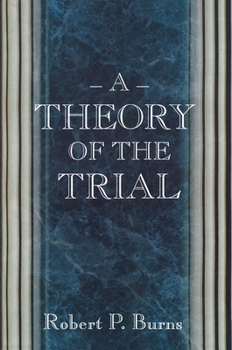A Theory of the Trial
Select Format
Select Condition 
Book Overview
Anyone who has sat on a jury or followed a high-profile trial on television usually comes to the realization that a trial, particularly a criminal trial, is really a performance. Verdicts seem determined as much by which lawyer can best connect with the hearts and minds of the jurors as by what the evidence might suggest. In this celebration of the American trial as a great cultural achievement, Robert Burns, a trial lawyer and a trained philosopher, explores how these legal proceedings bring about justice. The trial, he reminds us, is not confined to the impartial application of legal rules to factual findings. Burns depicts the trial as an institution employing its own language and styles of performance that elevate the understanding of decision-makers, bringing them in contact with moral sources beyond the limits of law. Burns explores the rich narrative structure of the trial, beginning with the lawyers' opening statements, which establish opposing moral frameworks in which to interpret the evidence. In the succession of witnesses, stories compete and are held in tension. At some point during the performance, a sense of the right thing to do arises among the jurors. How this happens is at the core of Burns's investigation, which draws on careful descriptions of what trial lawyers do, the rules governing their actions, interpretations of actual trial material, social science findings, and a broad philosophical and political appreciation of the trial as a unique vehicle of American self-government.
Format:Hardcover
Language:English
ISBN:0691007276
ISBN13:9780691007274
Release Date:July 1999
Publisher:Princeton University Press
Length:280 Pages
Weight:1.25 lbs.
Dimensions:0.9" x 6.0" x 9.0"
Customer Reviews
2 ratings
A theory book that delivers on its promises
Published by Thriftbooks.com User , 20 years ago
A Theory of the Trial brilliantly delivers what its title promises: an unconventional way of thinking about the idea of justice. If you are looking for a manual of trial practice, an anthology of case studies of famous trials, a collection of stories about notorious trials in history, look elsewhere. But if you are curious about the guiding principles-often unacknowledged and unexamined-operating beneath the surface of the trial system, forming its foundation, then A Theory of the Trial is for you. Burns, a practicing trial lawyer, professor of law, and professional philosopher, contrasts "the received view" (the view "according to the officials") about how juries (and judges) behave and the complex "intellectual operations" they actually perform while evaluating issues during the performance of the trial. Close study of four trials and reference to many others reveal decidedly more intricate intellectual operations than the official, received view understands. Juries continually sort through what Burns calls "a web of languages" spun during the trial. The key is paying attention to those languages. He does so in painstaking detail, thus setting up his final chapters, which require a patient reader. There Burns's philosophical mind goes to work, thinking systematically through competing positions and working toward his own. The argument proceeds brilliantly from its premises. Despite a pattern of references to scores of previous thinkers, it is conducted clearly and lucidly. For Burns, the trial is "one of the greatest achievements of our public culture." Ordinary citizens arrive at "truth-for-practical-judgment," truth that must be put into practice. Thereby, they influence public events in ways different from official, direct, top-down control. Does he overvalue the common sense of ordinary citizens? Perhaps, but today where else can we look for common sense and hard-won practical judgment? Burns's book makes its demands, but it delivers.
the key to understanding trials
Published by Thriftbooks.com User , 24 years ago
This is one of the best books available on the theories of contemporary justice. Burns uses a combination of scholarly sophistication and practical experience to explain why and how trials work so well at locating truth and doing justice.





